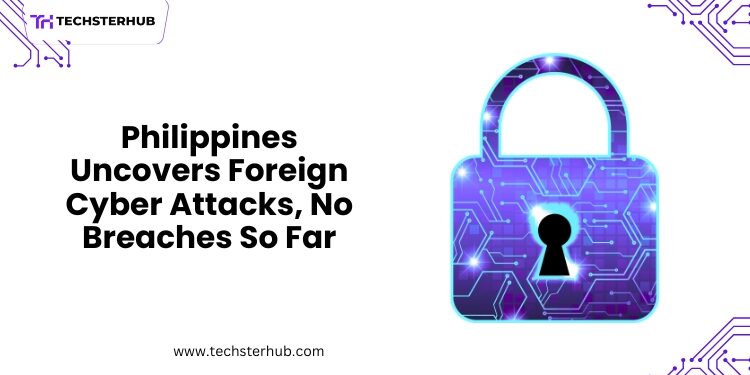The Philippines gained attention when government authorities announced foreign attempts to breach intelligence data through cyber intrusions. Despite the detection of intrusions authorities have confirmed sensitive information remained unbreeched. The recent news has triggered worries about national cybersecurity safety alongside growing global cyber-attack threats.
The article outlines the specifics of cyber intrusions while highlighting cybersecurity significance and explains the Philippines’ approach to addressing these threats. We’ll simplify this topic so you can understand it.
What Are Cyber Intrusions?
Understanding the concept of cyber intrusion is essential before we examine the details. Unauthorized individuals or groups conduct a cyber intrusion when they attempt to gain access to or launch an attack against a computer system, network, or digital platform. These attacks aim to achieve different objectives which include extracting information while other attacks focus on causing damage or creating service disruptions.
Foreign cyber attackers launched attacks against the intelligence systems of the Philippines. Storing essential national security data makes these systems highly vulnerable because a successful intrusion could endanger both the country’s safety and its privacy.
What Happened in the Philippines?
Government reports confirm that authorities identified and prevented these cyber-attacks from causing any damage. Foreign attackers tried to penetrate the country’s intelligence systems but failed to access sensitive information.
Though the sources of these attacks remain unidentified government officials believe they originated from state-sponsored actors. The source of these cyber intrusions might stem from countries or organizations that have political or economic motives.
The Philippines’ National Cybersecurity Council (NCSC) alongside the Department of Information and Communications Technology (DICT) is actively detecting these attacks and upgrading national digital defences. These efforts have successfully stopped attackers from accessing critical information up to now.
The Growing Threat of Cyberattacks
Cyber-attacks continue to grow in both frequency and complexity across the globe. Every day numerous nations, companies and private people encounter similar digital threats. Cyberattacks aim at various targets including government secrets and personal privacy information as well as financial data.
Hackers may attempt to obtain classified data which reveals a nation’s military strategies or political objectives. Attacking banking systems or power grids as well as communication networks can disrupt essential services which creates major problems for daily living.
The primary focus of foreign attackers in the Philippines was intelligence data. The threat of compromised intelligence data is concerning since it contains crucial information about national security measures and defense strategies among other important details. The nation would face severe consequences if attackers stole or leaked such sensitive information.
How Did the Philippines Prevent the Breach?
The Philippines has made substantial investments in cybersecurity to safeguard its government systems and protect sensitive information. The nation built strong cybersecurity systems that operate to find and stop cyber threats as they happen. Protective measures enabled the prompt identification of foreign cyber intrusions with no resulting harm.
The National Cybersecurity Center (NCSC) and the Department of Information and Communications Technology (DICT) routinely perform checks on government networks to detect cyber-attack signs. Safeguarding data is achieved through the use of sophisticated tools including firewalls, intrusion detection systems, and encryption techniques. These security procedures play a crucial role in defending sensitive information against unauthorized access.
The Philippines is collaborating with international partners to enhance its cybersecurity capabilities. The country joined global cybersecurity discussions while working together with other nations to exchange knowledge and best practices to defend against cyber threats.
The Importance of Cybersecurity in Today’s World
As the digital era progresses cybersecurity becomes increasingly essential. Because so much personal and government information exists online today, we must protect our systems from hackers and cybercriminals.
For governments, the stakes are even higher. The protection of intelligence data and military information along with other sensitive details determines national security. State security and stability face serious risks when hackers gain access to sensitive information.
In response to these threats the Philippines is taking proactive measures to improve cybersecurity and protect against future intrusions. The government has launched educational programs for its citizens and businesses to emphasize strong password usage and regular software updates along with safe online behavior.
How the Philippines is Strengthening Cybersecurity
The government of the Philippines has declared intentions to enhance its cybersecurity protocols in response to recent cyber intrusions. These steps outline the government’s strategy to defend against future cyber-attacks.
- Upgrading Cybersecurity Infrastructure: he Philippines currently focuses on updating its cybersecurity systems to enhance protection capabilities. The Philippines plans to enhance its cybersecurity systems through improved detection and defense capabilities to combat evolving cyber threats.
- Training and Awareness Programs: The government funds training for cybersecurity experts while teaching citizens how to safely navigate online spaces. The government aims to decrease cyber-attack risks by educating its population.
- Collaborating with Global Partners: The Philippines engages with international partners to exchange data about potential cybersecurity threats. International cooperation enables countries to establish stronger defences against cyber threats that impact multiple nations.
- Legislation and Policies: The government is improving cybersecurity legislation and regulations to ensure cybercriminals face legal consequences. The new measures will both obstruct hackers from launching attacks and establish penalties for law violations.
What Does This Mean for the Philippines?
The Philippines must recognize the urgency of cyber threats after recent foreign cyber intrusions. The presence of cyber threats serves as an ongoing warning that nations need to maintain vigilance to defend their digital infrastructure. The absence of stolen or leaked sensitive data does not justify complacency for the Philippines.
The Philippines cybersecurity agencies will persist in network monitoring and defense improvement while collaborating on an international level to fight against cybercrime. To protect its national security and citizen privacy the Philippines must maintain a strategic advantage over cyber attackers.
Conclusion
Countries worldwide face increasing cyber threats while the Philippines now finds itself at the forefront of this digital confrontation. The recent foreign cyber-attacks caused no breaches but they underscore the crucial requirement for robust cybersecurity defences. The Philippines focuses on advanced technology investments along with international collaborations and public education to secure its digital future.
The Philippines plans to maintain vigilance so that it stays ahead of the evolving threats that technology advancements bring.











